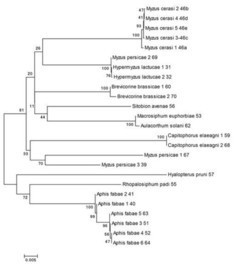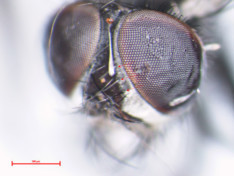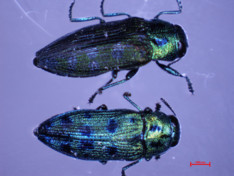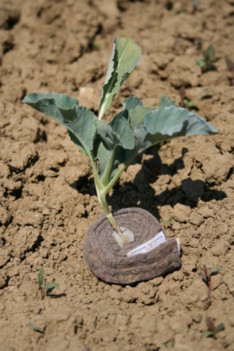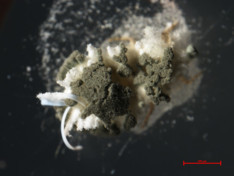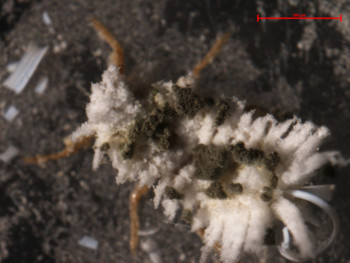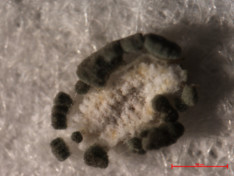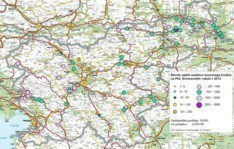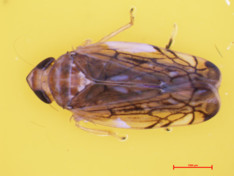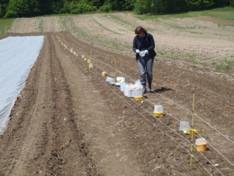Morphological and Molecular Classification of Insects
Microscopic techniques, supported by digital image capture and processing are routinely used in the entomological laboratory, as well as classic morphological identification of insects and their natural enemies.
Morphological identification of insects and parasitoids is supported by molecular diagnostic methods (DNA barcoding). The obtained mitochondrial DNA sequences are added to the international electronic database (Barcode of Life Data Systems). We also develop new molecular methods for discrimination of different populations of insects (e.g. separation of eastern and western populations of western corn rootworm in Slovenia) and the classification of insects (PCR-RFLP).
Phylogenetic tree of more important plant lice species
Morphological analysis of the classification characteristics of root flies
Diagnostics and Consultancy
In the Entomological Laboratory, we regularly perform examinations and identification of harmful and useful species of insects based on morphological and/or genetic properties. Besides the identification, we also provide consultations for clients about the suitable methods of controlling pests.
Cypress jewel beetle Ovalisia festiva, an important pest in hedges (especially Thuja sp.)
National surveys of quarantine and invasive insect pests
Citrus (Anoplophora chinensis) and asian longhorned beetle (A. glabripennis); (Coleoptera, Cerambycidae)
Agricultural Institute of Slovenia initiated a program of systematic identification of the presence of the Chinese (Anoplophora chinensis) and the Asian beetle (Anoplophora glabripennis) in 2008 under the authority of Phytosanitary Administration and in accordance with the Plant Protection and Regulation of the measures and procedures to prevent the introduction and spread of pests of plants, plant products and regulated items act.
Exotic species of beetle pests due to globalization and increasing international trade threaten trees in the urban environment and our forests. They are also dangerous pests of intensive plantations of fruit trees (especially apples and pears). With the systematic survey of the presence of Anoplophora chinensis and Anoplophora glabripennis we want to prevent the introduction and spread of these pests in Slovenia.
EXPERT WORK
Population dynamics monitoring of Western corn rootworm (Diabrotica virgifera virgifera)
Systematic surveillance of Western corn rootworm, Diabrotica virgifera virgifera LeConte, (Coleoptera, Chrysomelidae) has been performed since 1997 in Slovenia. In the European Union it was included in A2 quarantine pest list as per Council Directive 2000/29/EC, as summarized by the Commission decision 2003/766/EC and Commission Recommendation 2006/565/EC. As the pest can no longer be constrained, it was removed from the quarantine list in February 2014. Despite this technicality, it is a serious pest, which is still expanding in the EU. It has a potential for significant population growth, should we abandon the measures for its control. Therefore, it is paramount that intensive monitoring be performed and correct control measures be undertaken. Among these, crop rotation is most effective. The Plant Protection Department will continue to maintain a tight monitoring programme of the pest, to determine the pest’s population increase and spread, and to monitor for potential economic damage.
Spotted wing drosophila (Drosophila suzukii)
Spotted wing drosophila (Drosophila suzukii; SWD) is a relatively new pest of many fruit species, which have a thin skin and soft flesh. These are mainly berries (strawberries, raspberries, blackberries, currants, blueberry, elderberry) and stone fruits (cherries, apricots, peaches and plums). However, SWD attacks also grapes, figs and fruits of various native plants. SWD attacks fruits during ripening and can cause significant damage, especially during rainy weather. Unlike other types of flies, PVV can attack completely healthy fruit. For the purposes of prognosis and counselling PVV monitoring is carried out at several locations in central and north western Slovenia.
Research and monitoring of aphidofauna
Intensive agriculture and the climate change affect many plant pests. Among them are the Aphididae, which are so-called indicators of changes in the natural environment. We are routinely finding new species of aphids in Slovenia, from this it is clear that aphidofauna is changing. We have also observed the migration of new invasive species of aphids. To reduce the economic damage caused by aphids, we monitor the abundance and species representation in the major seed-potato field crops in Slovenia. Even more important is the indirect damage caused by aphids’ transmits of different plant viruses. Thus, the presence of aphids reduces yield and increases the use of plant protection products, which in turn affect food safety and the environment. By monitoring the aphids’ population dynamics at the time of mass migration on a particular area we can forecast the most suitable time for spraying.
RESEARCH
Biological control of arthropod pests
Entomology group is actively involved in biological control research, with a focus on the search for new isolates of entomopathogenic fungi. The newly discovered isolates are tested for their pathogenicity and virulence first on model insects such as wax moth (Galleria mellonella) and mealworm (Tenebrio molitor), and then on important agronomic pests such as spotted wing drosophila (Drosophila suzukii), wireworms (Agriotes spp.), cabbage flea beetles (Phyllotreta spp.), cabbage root fly (Delia radicum)... Acquired isolates of entomopathogenic fungi are further tested for their rhizosphere competence and potential endophytic lifestyle.
We also investigate the parasitoids of major agricultural pest as for example: aphids (Aphididae), flea beetles (Phyllotreta spp.), European corn borer (Ostrinia nubilalis), diamondback moth (Plutella xylostella, Plutellidae), cabbage root fly (Delia radicum) and swede midge (Contarinia nasturtii, Cecidomyiidae).
Integrated pest management
In the context of expert tasks and national and international research projects we study and develop innovative integrated pest management (IPM) strategies. Our main objective is sustainable intensification of local production of high-quality food. Our focus is threefold: a) diagnosis and monitoring of insect pests; b) biological control and c) sustainable use of plant protection products. New IPM strategies are tested in Slovenian production systems to confirm their usefulness in Slovenia. IPM research results are disseminated to Slovenian producers through workshops, counselling, lectures and publications in expert or scientific journals.
Plant physiology research
Research on insect-plant and fungus-plant interactions is supported by measurements of plant physiology. It is known that many pests inhabit plants’ vascular system, and thereby affect the transfer of nutrients and water in plant, which in turn affects the composition of pigments in chloroplasts and photosynthesis. Among the standard techniques of assessment of the impact on photosynthesis and water stress include measurements of chlorophyll fluorescence and hyperspectral imaging. Chlorophyll fluorescence has become a common tool for non-invasive assessment of photosynthetic performance of plants in plant physiology and ecophysiology. Monitoring of primary photochemistry is extremely useful in studies of high temperature, chilling, high light, nutrient and drought stress. Hyperspectral imaging offers high potential as a non-invasive diagnostic tool for studying plant stress, yield and biomass. It enables us monitoring of seasonal or yearly physiological, structural, phonological and biophysical parameters of vegetation as well as early disease detection.
Entomofauna in agroecosystems
In various agroecosystems (fields, vineyards, and orchards) we study the species composition and population dynamics of beneficial and harmful insects.
Equipment
- Leica M205C, motorized stereomicroscope
- Nikon SMZ800, stereomicroscope
- Mini PAM Walz, pulse amplitude modulation chlorophyll a fluorometer
- Growth chamber
- Plastic and glass insectariums
Prenos datotek
- Varstvo koruze pred koruznim hroščem PDF 2,064 kb
